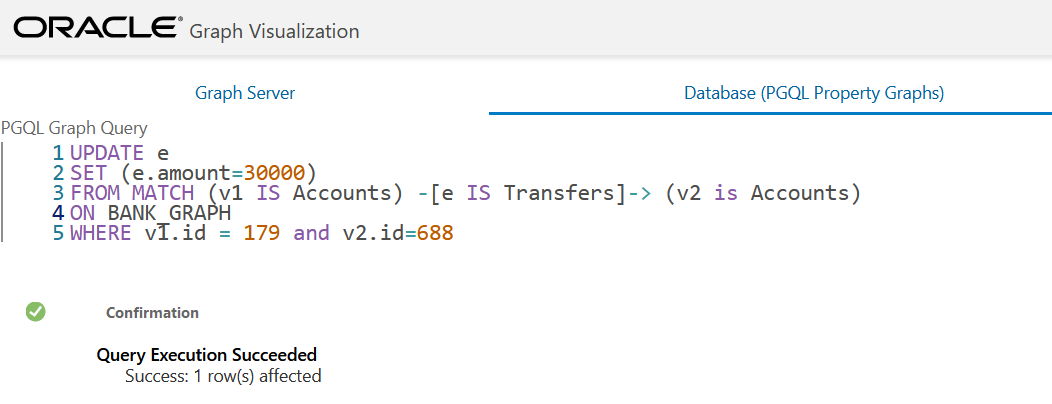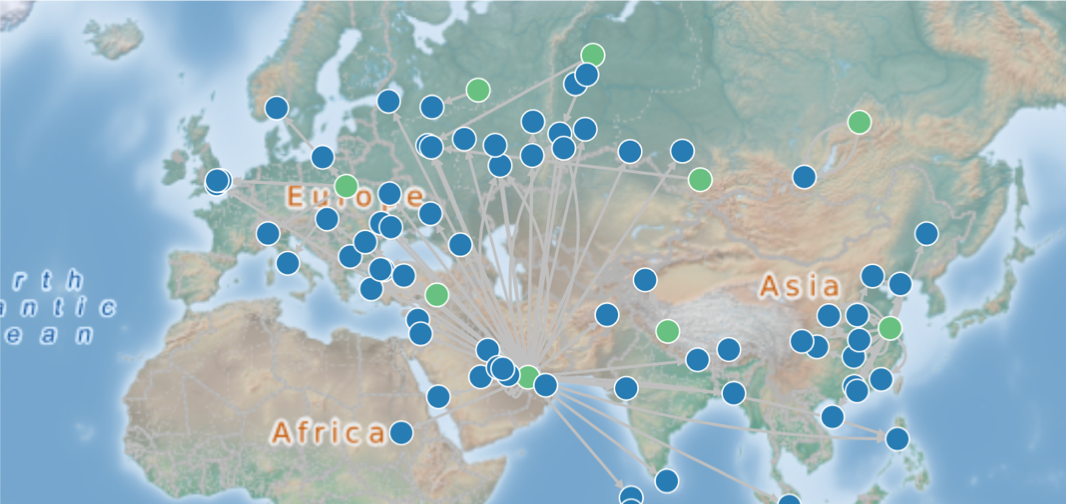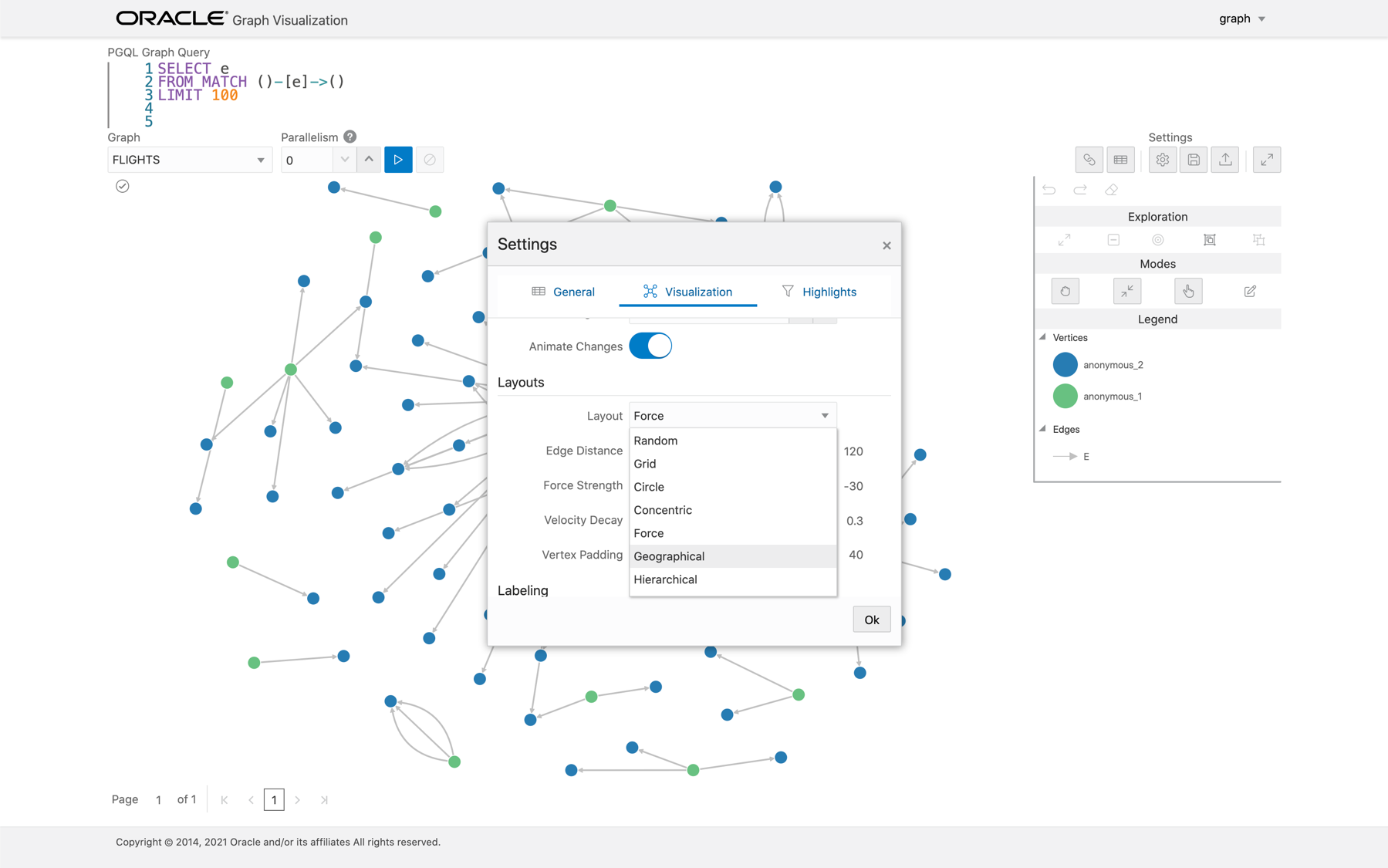21 Using the Graph Visualization Application
Using the Graph Visualization application, you can run PGQL queries on graphs in the graph server (PGX) and database.
The principal point of entry for the Graph Visualization application is the query editor which comprises the following tab options:
- Graph Server: To visualize graphs loaded into the graph server (PGX).
- Database (PGQL Property Graphs): To visualize PGQL property graphs in the database.
- Database (SQL Property Graphs): To visualize SQL property graphs. This tab option is supported only with Oracle Database 23ai.
Note that you can view the list of graphs available in the respective tabs by clicking the List of available graphs icon in the bottom panel of the application. The visualization results for the queries are also displayed in this panel.
The following sections explain the application user interface for running the various supported queries for visualization in detail:
- Visualizing PGQL Queries on Graphs Loaded Into the Graph Server (PGX)
You can visualize PGQL queries on graphs loaded into the graph server (PGX) in the Graph Server tab of the Graph Visualization application. - Visualizing PGQL Queries on PGQL Property Graphs
You can visualize PGQL queries on PGQL property graphs in the database in the Database (PGQL Property Graphs) tab of the Graph Visualization application. - Visualizing Graph Queries on SQL Property Graphs
You can query and visualize a SQL property graph in the database in the Database (SQL Property Graphs) tab of the Graph Visualization application. - Graph Visualization Modes
The buttons on the right let you switch between two modes: Graph Manipulation and Zoom/Move. - Graph Visualization Settings
You can click the Settings gear icon to display the Graph Visualization settings window. - Using the Geographical Layout
The Graph Visualization application offers a choice of layouts for rendering graphs. One of them is the Geographical layout that will show the graph (vertices and edges) on a global map. - Using Live Search
Live Search lets you to search the displayed graph and add live fuzzy search score to each item, so you can create a Highlight which visually shows the results of the search in the graph immediately.
Parent topic: Graph Visualization Application
21.1 Visualizing PGQL Queries on Graphs Loaded Into the Graph Server (PGX)
You can visualize PGQL queries on graphs loaded into the graph server (PGX) in the Graph Server tab of the Graph Visualization application.
Once you login to the Graph Visualization application, navigate to the Graph Server tab in the query editor. Enter a PGQL query on the desired graph and click the Run Query icon to execute the query.
Note:
Creating a property graph using theCREATE PROPERTY GRAPH statement is not supported.
The following figure shows a query visualization identifying all edges that are directed edges from any vertex in the graph to any other vertex.
On successful execution, the graph visualization result (including nodes and their connections) is displayed in the bottom panel. You can right-click a node or connection to display tooltip information, and you can drag the nodes around.
Parent topic: Using the Graph Visualization Application
21.2 Visualizing PGQL Queries on PGQL Property Graphs
You can visualize PGQL queries on PGQL property graphs in the database in the Database (PGQL Property Graphs) tab of the Graph Visualization application.
You can create, query, modify and visualize PGQL property graphs in the database using the Graph Visualization application. The following PGQL operations are supported:
CREATE PROPERTY GRAPH: To create a new PGQL property graph as shown:Figure 21-2 Creating a PGQL property graph

Description of "Figure 21-2 Creating a PGQL property graph"INSERT,UPDATEandDELETE: To modify an existing PGQL property graph. For example:Figure 21-3 Updating an Edge in a PGQL property graph

Description of "Figure 21-3 Updating an Edge in a PGQL property graph"Note that you must provide the graph name in the PGQL query. You can click the List of available graphs icon to view the list of PGQL property graphs to which you have access.
Figure 21-4 Deleting an Edge in a PGQL property graph

Description of "Figure 21-4 Deleting an Edge in a PGQL property graph"SELECT: To query a PGQL property graph as shown:Figure 21-5 Querying a PGQL property graph

Description of "Figure 21-5 Querying a PGQL property graph"DROP PROPERTY GRAPH: To delete a PGQL property graph as shown:Figure 21-6 Dropping a PGQL property graph

Description of "Figure 21-6 Dropping a PGQL property graph"
Parent topic: Using the Graph Visualization Application
21.3 Visualizing Graph Queries on SQL Property Graphs
You can query and visualize a SQL property graph in the database in the Database (SQL Property Graphs) tab of the Graph Visualization application.
Note:
The Database (SQL Property Graphs) tab option in the Graph Visualization application is only available with Oracle Database 23ai.However, in order to visualize the vertices and edges of a
GRAPH_TABLE query together with their IDs and all their labels and
properties, the query must return the vertex ID, or edge ID, or both.
For example, the following figure shows the visualization of a SQL
GRAPH_TABLE query on a SQL property graph. Note that the
COLUMNS clause in the query uses the VERTEX_ID and
EDGE_ID operators.
Note:
- In addition to the privileges mentioned in Privileges to Query a SQL Property Graph, you must also have the
CREATE VIEWandCREATE MATERIALIZED VIEWprivileges to query and visualize a SQL property graph in the Graph Visualization application. - The Graph Visualization application supports only
SELECTgraph queries.
Figure 21-7 Graph Query on a SQL Property Graph

Description of "Figure 21-7 Graph Query on a SQL Property Graph"
The name of the graph must be provided in the SQL graph query. You can click the List of available graphs icon (shown highlighted in the preceding figure) to view the list of SQL property graphs to which you have access.
See Also:
SQL Graph Queries for more informationParent topic: Using the Graph Visualization Application
21.4 Graph Visualization Modes
The buttons on the right let you switch between two modes: Graph Manipulation and Zoom/Move.
- Graph Manipulation mode lets you execute actions that modify the visualization. These actions include:
- Drop removes selected vertices from visualization. Can also be executed from the tooltip.
- Group selects multiple vertices and collapses them into a single one.
- Ungroup selects a group of collapsed vertices and ungroups them.
- Expand retrieves a configurable number of neighbors (hops) of selected vertices. Can also be executed from the tooltip.
- Focus, like Expand, retrieves a configurable number of neighbors, but also drops all other vertices. Can also be executed from the tooltip.
- Undo undoes the last action.
- Redo redoes the last action.
- Reset resets the visualization to the original state after the query.
- Zoom/Move mode lets you zoom in and out, as well as to move to another part of the visualization. The Pan to Center button resets the zoom and returns the view to the original one.
An additional mode, called Sticky mode, lets you cancel the action of dragging the nodes around.
Parent topic: Using the Graph Visualization Application
21.5 Graph Visualization Settings
You can click the Settings gear icon to display the Graph Visualization settings window.
The settings window lets you modify some parameters for the visualization, and it has tabs for General, Visualization, and Highlights. The following figure shows this window, with the Visualization tab selected.
Figure 21-8 Graph Visualization Settings Window

Description of "Figure 21-8 Graph Visualization Settings Window"
The General tab includes the following:
- Number of hops: The configurable number of hops for the expand and focus actions.
- Truncate label: Truncates the label if it exceeds the maximum length.
- Max. visible label length: Maximum length before truncating.
- Show Label On Hover: Controls whether the label is shown on hover.
- Display the graph legend: Controls whether the legend is displayed.
The Visualization tab includes the following:
- Theme: Select a light or dark mode.
- Edge Style: Select straight or curved edges.
- Edge Marker: Select arrows or no edge marker. This only applies to directed edges.
- Similar Edges: Select keep or collect.
- Page Size: Specify how many vertices and edges are displayed per page.
- Layouts: Select between different layouts (random, grid, circle, concentric, ...).
- Vertex Label: Select which property to use as the vertex label.
- Vertex Label Orientation: Select the relative position of the vertex label.
- Edge Label: Select which property to use as the edge label.
The Highlights tab includes customization options that let you modify the appearance of edges and vertices. Highlighting can be applied based on conditions (filters) on single or multiple elements. The following figure shows a condition (country = United States) and visual highlight options for vertices.
Figure 21-9 Highlights Options for Vertices

Description of "Figure 21-9 Highlights Options for Vertices"
A filter for highlights can contain multiple conditions on any property of the element. The following conditions are supported.
=(equal to)<(less than)<=(less than or equal to)>(greater than)>=(greater than or equal to)!=(not equal to)~(filter is a regular expression)*(any: like a wildcard, can match to anything)
The visual highlight customization options include:
- Edges:
- Width
- Color
- Label
- Style
- Animations
- Vertices:
- Size
- Color
- Icon
- Label
- Image
- Animations
You can export and import highlight options by clicking the Save and Import buttons in the main window. Save lets you persist the highlight options, and Load lets you apply previously saved highlight options.
When you click Save, a file is saved containing a JSON object with the highlights configuration. Later, you can load that file to restore the highlights of the saved session.
Parent topic: Using the Graph Visualization Application
21.6 Using the Geographical Layout
The Graph Visualization application offers a choice of layouts for rendering graphs. One of them is the Geographical layout that will show the graph (vertices and edges) on a global map.
+-------------------------------------------------+
| iata | city | longitude | latitude |
+-------------------------------------------------+
| SIN | Singapore | 103.994003 | 1.35019 |
| LAX | Los Angeles | -118.4079971 | 33.94250107 |
| MUC | Munich | 11.7861 | 48.353802 |
| CDG | Paris | 2.55 | 49.012798 |
| LHR | London | -0.461941 | 51.4706 |
+-------------------------------------------------+Note:
You can use any name for the longitude and latitude properties (such as X and Y, or long and lat). But, you must ensure that the longitude/latitude pair are in the WGS84 system (GPS coordinates), and the coordinates are expressed in decimal degrees.Then, select the properties in your vertices that contain the geographical coordinates as shown:
Figure 21-12 Selecting the Coordinates for the Geographical layout

Description of "Figure 21-12 Selecting the Coordinates for the Geographical layout"
You can now move around the map and zoom in/out using your mouse or trackpad. From now on, whenever you enter a new PGQL query, the map will automatically center and zoom the vertices returned by the query.
Parent topic: Using the Graph Visualization Application
21.7 Using Live Search
Live Search lets you to search the displayed graph and add live fuzzy search score to each item, so you can create a Highlight which visually shows the results of the search in the graph immediately.
If you run a query, and a graph is displayed, you can add the live search, which is on the settings dialog. On the bottom of the General tab, you will see these options.
- Enable Live Search: Enables the Live Search feature, adds the search input to the visualization, and lets you further customize the search.
- Enable Search In: You can select whether you want to search the properties of Vertices, Edges, or both.
- Properties To Search: Based on what you selected for Enable Search In, you can set one or more properties to search in. For example, if you disable the search for edges but you had a property from edges selected, it will be stored and added back when you enable search for the edges again. (This also works for vertices.)
- Advanced Settings: You can fine-tune the search even more. Each of the advanced options is documented with context help, visible upon enabling.
- Location: Determines approximately where in the text the pattern is expected to be found.
- Distance: Determines how close the match must be to the fuzzy location (specified by location). An exact letter match which is distance characters away from the fuzzy location would score as a complete mismatch. A distance of 0 requires the match be at the exact location specified, a distance of 1000 would require a perfect match to be within 800 characters of the location to be found using a threshold of 0.8.
- Maximum Pattern Length: The maximum length of the pattern. The longer the pattern (that is, the search query), the more intensive the search operation will be. Whenever the pattern exceeds this value, an error will be thrown.
- Min Char Match: The minimum length of the pattern. Whenever the pattern length is below this value, an error will be thrown.
When the search is enabled, the input will be displayed in the top left part of the Graph Visualization component. If you start typing, the search will add a score to every vertex or edge, based on the settings and the search match.
To be able to see the results visually, you have to add a Highlight with interpolation set to a Live Search score and other settings based on the desired visual change.
Parent topic: Using the Graph Visualization Application


